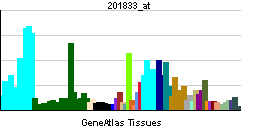Histone deacetylase 2
| Histone deacetylase 2 | |||||||||||
|---|---|---|---|---|---|---|---|---|---|---|---|
| Identifiers | |||||||||||
| Symbols | HDAC2 ; RPD3; YAF1 | ||||||||||
| External IDs | Template:OMIM5 Template:MGI HomoloGene: 68187 | ||||||||||
| |||||||||||
| RNA expression pattern | |||||||||||
 | |||||||||||
| More reference expression data | |||||||||||
| Orthologs | |||||||||||
| Template:GNF Ortholog box | |||||||||||
| Species | Human | Mouse | |||||||||
| Entrez | n/a | n/a | |||||||||
| Ensembl | n/a | n/a | |||||||||
| UniProt | n/a | n/a | |||||||||
| RefSeq (mRNA) | n/a | n/a | |||||||||
| RefSeq (protein) | n/a | n/a | |||||||||
| Location (UCSC) | n/a | n/a | |||||||||
| PubMed search | n/a | n/a | |||||||||
Histone deacetylase 2, also known as HDAC2, is a human gene.
This gene product belongs to the histone deacetylase family. Histone deacetylases act via the formation of large multiprotein complexes and are responsible for the deacetylation of lysine residues on the N-terminal region of the core histones (H2A, H2B, H3 and H4). This protein also forms transcriptional repressor complexes by associating with many different proteins, including YY1, a mammalian zinc-finger transcription factor. Thus it plays an important role in transcriptional regulation, cell cycle progression and developmental events.[1]
See also
References
Further reading
- Ahringer J (2000). "NuRD and SIN3 histone deacetylase complexes in development". Trends Genet. 16 (8): 351–6. PMID 10904264.
- Verdin E, Dequiedt F, Kasler HG (2003). "Class II histone deacetylases: versatile regulators". Trends Genet. 19 (5): 286–93. PMID 12711221.
- Zhang Y, Dufau ML (2003). "Dual mechanisms of regulation of transcription of luteinizing hormone receptor gene by nuclear orphan receptors and histone deacetylase complexes". J. Steroid Biochem. Mol. Biol. 85 (2–5): 401–14. PMID 12943729.
- Furukawa Y, Kawakami T, Sudo K; et al. (1996). "Isolation and mapping of a human gene (RPD3L1) that is homologous to RPD3, a transcription factor in Saccharomyces cerevisiae". Cytogenet. Cell Genet. 73 (1–2): 130–3. PMID 8646880.
- Yang WM, Inouye C, Zeng Y; et al. (1996). "Transcriptional repression by YY1 is mediated by interaction with a mammalian homolog of the yeast global regulator RPD3". Proc. Natl. Acad. Sci. U.S.A. 93 (23): 12845–50. PMID 8917507.
- Laherty CD, Yang WM, Sun JM; et al. (1997). "Histone deacetylases associated with the mSin3 corepressor mediate mad transcriptional repression". Cell. 89 (3): 349–56. PMID 9150134.
- Zhang Y, Iratni R, Erdjument-Bromage H; et al. (1997). "Histone deacetylases and SAP18, a novel polypeptide, are components of a human Sin3 complex". Cell. 89 (3): 357–64. PMID 9150135.
- Yang WM, Yao YL, Sun JM; et al. (1997). "Isolation and characterization of cDNAs corresponding to an additional member of the human histone deacetylase gene family". J. Biol. Chem. 272 (44): 28001–7. PMID 9346952.
- Hassig CA, Tong JK, Fleischer TC; et al. (1998). "A role for histone deacetylase activity in HDAC1-mediated transcriptional repression". Proc. Natl. Acad. Sci. U.S.A. 95 (7): 3519–24. PMID 9520398.
- Randhawa GS, Bell DW, Testa JR, Feinberg AP (1998). "Identification and mapping of human histone acetylation modifier gene homologues". Genomics. 51 (2): 262–9. doi:10.1006/geno.1998.5370. PMID 9722949.
- Betz R, Gray SG, Ekström C; et al. (1998). "Human histone deacetylase 2, HDAC2 (Human RPD3), is localized to 6q21 by radiation hybrid mapping". Genomics. 52 (2): 245–6. doi:10.1006/geno.1998.5435. PMID 9782097.
- Zhang Y, LeRoy G, Seelig HP; et al. (1998). "The dermatomyositis-specific autoantigen Mi2 is a component of a complex containing histone deacetylase and nucleosome remodeling activities". Cell. 95 (2): 279–89. PMID 9790534.
- Tong JK, Hassig CA, Schnitzler GR; et al. (1998). "Chromatin deacetylation by an ATP-dependent nucleosome remodelling complex". Nature. 395 (6705): 917–21. doi:10.1038/27699. PMID 9804427.
- Hsieh JJ, Zhou S, Chen L; et al. (1999). "CIR, a corepressor linking the DNA binding factor CBF1 to the histone deacetylase complex". Proc. Natl. Acad. Sci. U.S.A. 96 (1): 23–8. PMID 9874765.
- Yarden RI, Brody LC (1999). "BRCA1 interacts with components of the histone deacetylase complex". Proc. Natl. Acad. Sci. U.S.A. 96 (9): 4983–8. PMID 10220405.
- Koipally J, Renold A, Kim J, Georgopoulos K (1999). "Repression by Ikaros and Aiolos is mediated through histone deacetylase complexes". EMBO J. 18 (11): 3090–100. doi:10.1093/emboj/18.11.3090. PMID 10357820.
- Zhang Y, Ng HH, Erdjument-Bromage H; et al. (1999). "Analysis of the NuRD subunits reveals a histone deacetylase core complex and a connection with DNA methylation". Genes Dev. 13 (15): 1924–35. PMID 10444591.
- Ng HH, Zhang Y, Hendrich B; et al. (1999). "MBD2 is a transcriptional repressor belonging to the MeCP1 histone deacetylase complex". Nat. Genet. 23 (1): 58–61. doi:10.1038/12659. PMID 10471499.
- Wade PA, Gegonne A, Jones PL; et al. (1999). "Mi-2 complex couples DNA methylation to chromatin remodelling and histone deacetylation". Nat. Genet. 23 (1): 62–6. doi:10.1038/12664. PMID 10471500.
- Lai A, Lee JM, Yang WM; et al. (2000). "RBP1 recruits both histone deacetylase-dependent and -independent repression activities to retinoblastoma family proteins". Mol. Cell. Biol. 19 (10): 6632–41. PMID 10490602.
External links
- HDAC2+protein,+human at the US National Library of Medicine Medical Subject Headings (MeSH)
| This protein-related article is a stub. You can help Wikipedia by expanding it. |